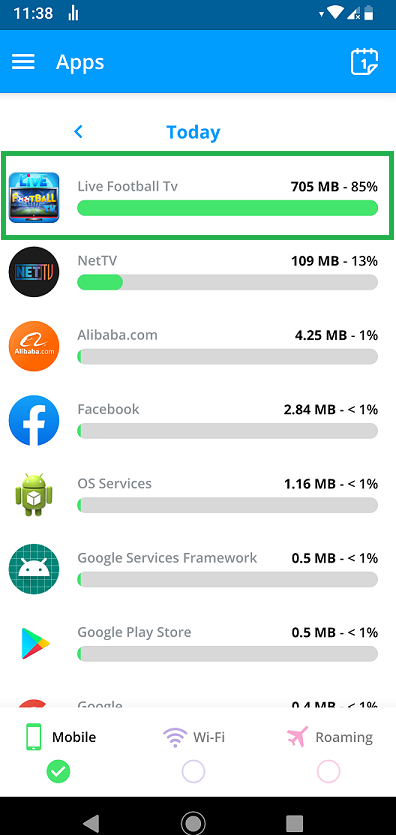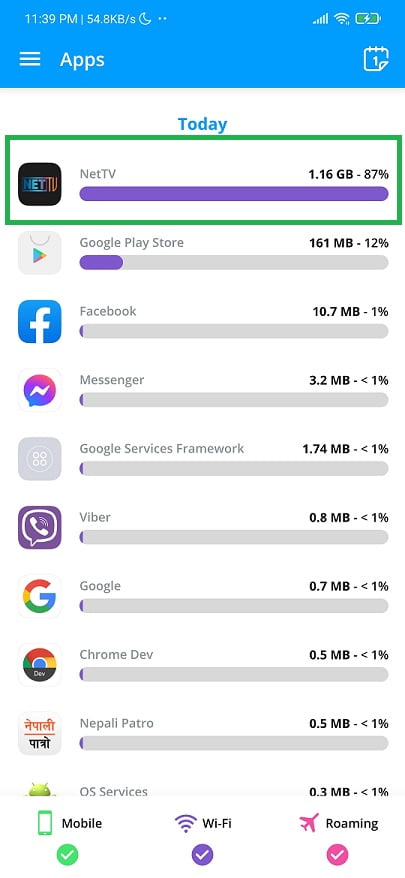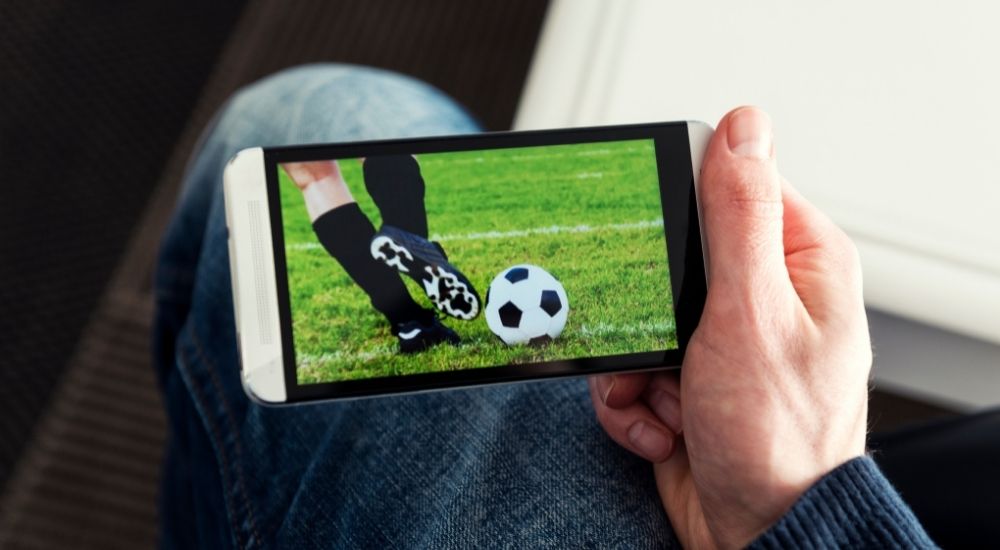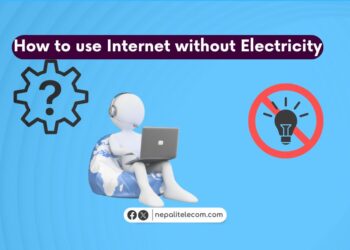Football’s two major competitions Euro and Copa America have gripped fans across the world. The two regional championships are contested by European and Latin American countries respectively but they are viewed with shared enthusiasm around the world. For them, it is no less than a carnival. Seeing their favorite players and team locking horns in crunch matches is a visual treat nobody wants to miss out and we Nepalese are no different.
Like everyone else, we cannot resist these competitions. Despite the unfavorable time zones, Nepali football fans hook themselves to their television sets beyond midnight not to miss a single minute. But for various reasons, not everyone can watch football matches on Television. For those, mobile apps are an excellent alternative. Besides, some love to watch on apps to keep the fervor exclusive to themselves. But the question many ask is how much data volume does it consume?
Watching football on handheld devices is a very pleasing convenience but bandwidth consumption must be considered, especially for those on limited data plans. For football fans in Nepal, there are options of digital tv apps and third-party apps from app stores. For our test, we streamed the same football match on SD and HD quality on both: a third-party app and the official NetTv app.
Before we move to the data stats, first let’s familiarize ourselves with basic factors which help us understand data consumption on each streaming of a football match.
Check out: Mobile data vs Wifi: Which one do you prefer?
Resolution Factor
The extent of bandwidth consumption on mobile phones depends on the resolution of the video. Besides, both video and audio bitrates and frames per second, among others also play a crucial role in how much data is being downloaded on your device every second.
You can witness discrepancies in bandwidth consumption while streaming video content on a laptop and on a smartphone. Due to the difference in screen size, the original content is compressed on smaller handheld devices. So, their data consumption is also lower compared to their large screen counterparts. 360p, 480p, 720p and 1080p are the common video resolutions while 4K is also becoming popular. Streaming videos in higher resolution results in higher bandwidth consumption.
What Internet speed do you need?
To stream a match, make sure you have the right bandwidth/speed on your internet connection. Because the resolution of the video has a direct relationship with bandwidth speed. Each type of resolution demands a certain minimum bandwidth/speed. If you don’t have the minimum speed, you can’t stream a match. But, generally, it shouldn’t be a problem these days.
To illustrate the resolution and bandwidth relation, we have taken references from Youtube. The world’s most popular video-sharing platform has options of up to 4K resolution videos. So, It is more than enough to help us sort out internet speed and resolution relationships.
| Video Resolution | Preferred Internet Speed |
|---|---|
| 4K | 20 Mbps |
| HD 1080p | 5 Mbps |
| HD 720p | 2.5 Mbps |
| SD 480p | 1.1 Mbps |
| SD 360p | 0.7 Mbps |
As the table illustrates, you would need at least a 1.1 Mbps connection to watch football matches on 480p resolution. Likewise, you would need a 2.5 Mbps connection for an HD stream. You can also check other resolutions and their corresponding speed requirement above.
The table certainly gives us good comfort because normally we can avail of such broadband speed in most areas these days. With 3G or 4G on mobile broadband or on WiFi from fiber connections, we can afford FULL HD quality matches on smartphones or tablets.
By today’s standard 480p should be the minimum resolution for proper viewing. The 720p resolution offers a high-quality viewing, while FULL HD or beyond provides the ultimate aesthetics with rich detail.
Now To The stats
Now let’s get to the stats. To ensure accurate statistics for our readers, we streamed the same match thoroughly on two devices including stoppage time and breaks-in-between which stretches the duration to a maximum of 120 minutes. Besides, we were on both mobile broadband and WiFi to test the bandwidth usage. As for the former, we switched on 4G to ensure uninterrupted video play. But stay confirmed that 3G would still be fine to pull through 720p or even 1080p videos on your smartphone. For the latter, we utilized WiFi for the full match. However, as 4G is now ubiquitous, it is better to use 4G network for smooth streaming. Checkout: 3G vs 4G mobile network; which one to use?
On each device, we used two separate apps. One: a third-party app from Play Store and the other: an official NetTv App with a full subscription. Now, let’s get to the nitty-gritty.
Third-Party App
Our third-party app from Google Play Store played the football match in SD resolution switching between 360p and 480p. Due to its obvious Standard Quality, it didn’t hog the bandwidth as much. In the total 120 minutes of play, it consumed 705 MB of data.

The app doesn’t come with the resolution option but again the original resolution was the standard HD variant we see on old CRT TVs. The 4G broadband didn’t let any possible glitches in-between till the end of the match and we got the stats we needed.
Check out: How to save mobile data on your phone?
TV Apps
If you are a subscriber to any ISP’s internet plan, then you may have a digital TV solution and its TV app. One key feature of such apps is they come with Picture-in-Picture mode (PiP) and you can play the videos while browsing through other apps or games.
For our testing, we availed of the NetTv app but the output is likely to be similar in other apps too. Just like on the third-party app, we ran the live match on a sports channel from the first to the last second. But unlike on the play store app, the NetTv app was playing the match on Full HD (1080p). We also figured the original video source was from BBC’s sports channel.
| Streaming Resolution | Duration (estimate) | Data Per Minute (In MB) | Bandwidth Consumption |
| SD (480p) | 120 minutes | 5.87 | 705 MB |
| HD (1080p) | 120 minutes | 9.90 | 1.16 GB |
This time the match’s Full HD streaming took 1.16 GB of data for the whole match. More precisely, our run time comprised the whole game, and the half time leading to around 120 minutes. To sum up, 1 GB was would be a good estimate for a 90 minutes football match on a normal day.

But there is no guarantee that a football match ends in the standard 90 minutes. In knockout matches, the game may stretch into the extra time of thirty minutes and even to the tie-breaker. To cover the data usage for such a possibility, let’s make another case below.
Read: IPTV vs Digital TV; Major Differences
In Case of Extra-Time
In knock-out stages, a single match could stretch well beyond 90 minutes when we take into account extra-time of 30 minutes, breaks, and the tie-breaker. This is why it is compelling enough to draw estimates for such matches too. For this though, we will only include data for HD streaming.
We will take 100 minutes for a match to include its stoppage time, a rough but reasonable duration. Let’s add 45 minutes for extra time including its own breaks and stoppage time. Further, being at liberty, we count 30 minutes for penalty shootouts that go beyond the first five kicks. Now that would stretch the match to 175 minutes. This duration should normally complete a match even with penalty shoot-outs. Now let’s move on to the bandwidth consumption.
Do Check out: How to watch Nepali TV channels online?
In Case of A Longer Match
As our test demonstrated, a 120 minute match on Full HD consumed a total of 1.16 GB of data that is slightly over 1,187 MB (1 GB=1,024 MB). That means it was taking about 9.90 MB of data per minute. Now, calculating the 175 minutes with 9.90 MB per minute gives us a total of about 1,733 MB (1.69 GB).
| Duration | Data Per Minute (In MB) | In MB | In GB |
| 175 minutes | 9.90 | 1,773 | 1.69 |
If you are watching a league match that concludes within its 90 minutes duration, our initial figure of 1.16 GB would suffice for you. However, for a knockout stage, the match that goes beyond 90 minutes of play and can’t find a winner extra time and needs a shoot-out, our second figure of 1.69 GB of data could get you the fun. However, these are the rough estimates and still, we have tried to stay as reasonable as we could so that the estimations don’t define rationality.
To sum up, 1.69 GB data would let you watch a football match in High Definition including extra time, penalty shoot-outs, in-game breaks, stoppage time, and all. But for convenience, have 2 GB of data with you so that it covers the duration beyond estimation here and you can enjoy an entire match without bandwidth issue.
Note: Above data usage volume is based on my device and the internet speed at that instant, So please kindly take it as a sample test.
Read this: NetTV Brings Cine+ Subscription to Access 3000+ Movies
Caution
It is easy to find many links to watch these matches on Facebook. But be careful. They are not from official sources and can be click baits with links to other sites. You may find such shady sources on YouTube too. These could potentially steal your data or infect your device with viruses or unwanted programs.
On app stores too, you will find many apps promising football matches streaming, but here again, move with caution. Some of them are malware or adware. They can be infested with viruses. So, don’t fall for any links that may potentially compromise your private data. It is best to only use apps from trusted sources.
If you have a home internet subscription, then you may also have a digital TV solution. It gives you an option to watch TV channels on its official app. It’s best to use those apps for security reasons.
Check out: How to get better mobile signal on your phone?
Takeaway
Streaming football matches or watching any videos whether is it on a smartphone or a laptop relates directly to the resolution of the video. The resolution of the videos is also referred to as SD and HD. 360p and 480p are known as SD resolution and the former is on the verge of extinction. 480p is what you see on old CRT televisions.
On flatscreens, the images are upscaled and their edge portions get cropped out. It is due to the mismatch between the resolution of the TV screen and that of the video. Meanwhile, 720p is the standard HD and 1080p is the real Hd or Full HD video resolution, and they are perfectly on today’s flatscreens.
Check out: How to unlock a locked phone; Android, Apple?
Are you also streaming football matches on your smartphones? Which app are you using? Does our bandwidth consumption match yours? Do let us know in the comments below.













